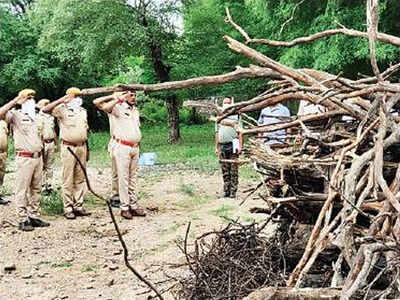
KOTA: A four-year-old tiger identified as MT–3, which had walked all the way from Ranthambore Tiger Reserve to Mukundara Hills Tiger Reserve (MHTR) covering a distance of around 200km a year ago, was found dead under mysterious conditions near a waterbody in Mashalpura area of MHTR, on Thursday.
The tiger, which was last spotted limping with one of its hind legs, had no external injuries. Vets who conducted the postmortemsaid it could have died of severe lungs infection or cardiac arrest. According to them, the tiger had lung infection and an enlarged heart with clots in the chambers.
A three-member medical board comprising Dr Rajiv Garg from Swaimadhopur and Dr Akhilesh Pandey and Tejendra Reyad of MHTR conducted the autopsy on Thursday and later cremated the body in presence of CCF Anand Mohan, DCF T. Mohanraj, SDM Ramganjmandi and the DSP of the area.
According to MHTR officials, the monitoring team had spotted MT-3 limping with left hind leg with no visible physical injuries following which monitoring was intensified and a pet was offered to the animal on the same day to check if there was any health related abnormality. But the big cat made the kill and ate it.
When no improvement was seen in the animal, MHTR authorities sought permission for tranquilization and called Dr Rajiv Garg who reached Kota from Swaimadhopur on Wednesday. The animal was to be tranquilized on Thursday morning, but before the operation, it was found dead.
The tiger had slowed down its movement since Friday and halted at a place on Sunday, deputy conservator of forests T. Mohanraj said. “Forest teams were regularly monitoring the animal and it walked around 15km daily. But nobody thought it would die so soon,” he added.
“Severe infection was found in the lungs and blood clots and fat were found accumulated in the heart that were blocking the chambers. The size of heart had also enlarged,” Garg said.
Samples of all the vital organs have been taken to send to a lab for examination to ascertain actual reason of death, he said, adding the mixed with blood and pus was pouring out the body of the tiger after its death and it indicated some long-term infection.
Disappointed with the sudden death of MT-3, wildlife enthusiasts questioned the monitoring by forest officials in MHTR. ‘Had there been proper monitoring, the physical disorder or disease of MT-3 could have been diagnosed on time and the animal could have been treated,” Brijesh Vijayvergaya, a wildlife enthusiast in Kota, said.
MT-3 was known as T-98 in Ranthambore Tiger Reserve and it was the offspring of tigress T-60.
The tiger, which was last spotted limping with one of its hind legs, had no external injuries. Vets who conducted the postmortemsaid it could have died of severe lungs infection or cardiac arrest. According to them, the tiger had lung infection and an enlarged heart with clots in the chambers.
A three-member medical board comprising Dr Rajiv Garg from Swaimadhopur and Dr Akhilesh Pandey and Tejendra Reyad of MHTR conducted the autopsy on Thursday and later cremated the body in presence of CCF Anand Mohan, DCF T. Mohanraj, SDM Ramganjmandi and the DSP of the area.
According to MHTR officials, the monitoring team had spotted MT-3 limping with left hind leg with no visible physical injuries following which monitoring was intensified and a pet was offered to the animal on the same day to check if there was any health related abnormality. But the big cat made the kill and ate it.
When no improvement was seen in the animal, MHTR authorities sought permission for tranquilization and called Dr Rajiv Garg who reached Kota from Swaimadhopur on Wednesday. The animal was to be tranquilized on Thursday morning, but before the operation, it was found dead.
The tiger had slowed down its movement since Friday and halted at a place on Sunday, deputy conservator of forests T. Mohanraj said. “Forest teams were regularly monitoring the animal and it walked around 15km daily. But nobody thought it would die so soon,” he added.
“Severe infection was found in the lungs and blood clots and fat were found accumulated in the heart that were blocking the chambers. The size of heart had also enlarged,” Garg said.
Samples of all the vital organs have been taken to send to a lab for examination to ascertain actual reason of death, he said, adding the mixed with blood and pus was pouring out the body of the tiger after its death and it indicated some long-term infection.
Disappointed with the sudden death of MT-3, wildlife enthusiasts questioned the monitoring by forest officials in MHTR. ‘Had there been proper monitoring, the physical disorder or disease of MT-3 could have been diagnosed on time and the animal could have been treated,” Brijesh Vijayvergaya, a wildlife enthusiast in Kota, said.
MT-3 was known as T-98 in Ranthambore Tiger Reserve and it was the offspring of tigress T-60.

Coronavirus outbreak
Trending Topics
LATEST VIDEOS
More from TOI
Navbharat Times
Featured Today in Travel
Quick Links
Kerala Coronavirus Helpline NumberHaryana Coronavirus Helpline NumberUP Coronavirus Helpline NumberBareilly NewsBhopal NewsCoronavirus in DelhiCoronavirus in HyderabadCoronavirus in IndiaCoronavirus symptomsCoronavirusRajasthan Coronavirus Helpline NumberAditya ThackerayShiv SenaFire in MumbaiAP Coronavirus Helpline NumberArvind KejriwalJammu Kashmir Coronavirus Helpline NumberSrinagar encounter
Get the app









